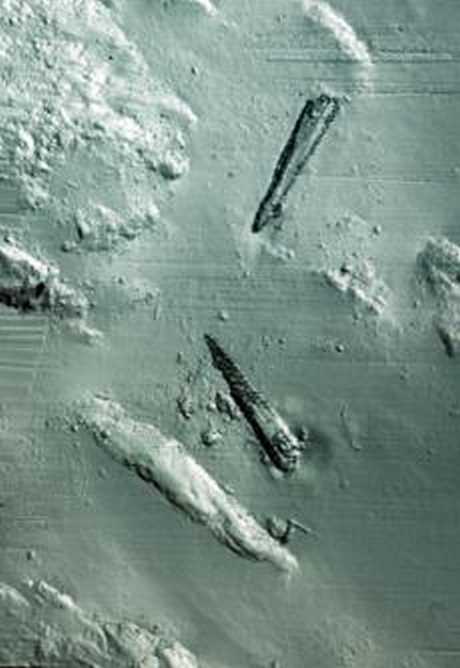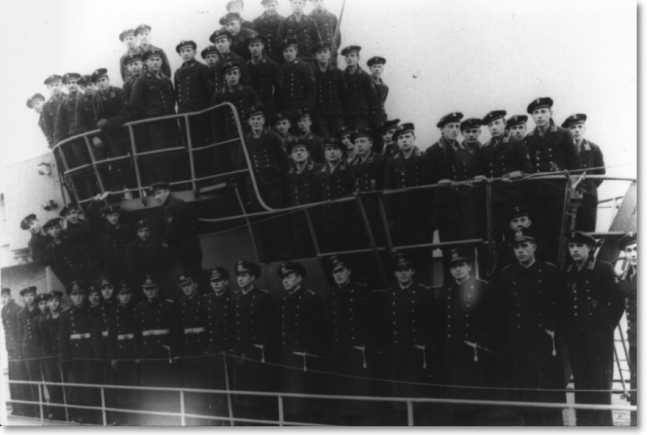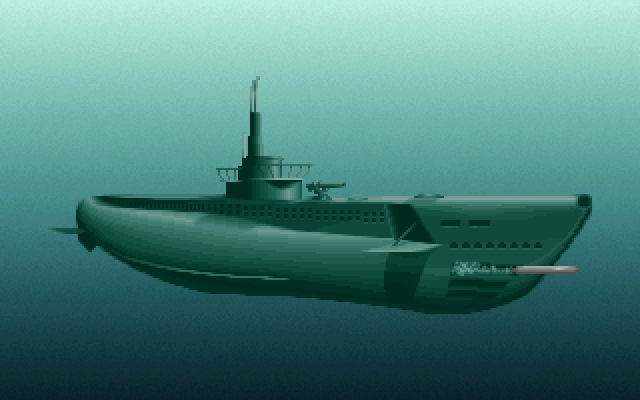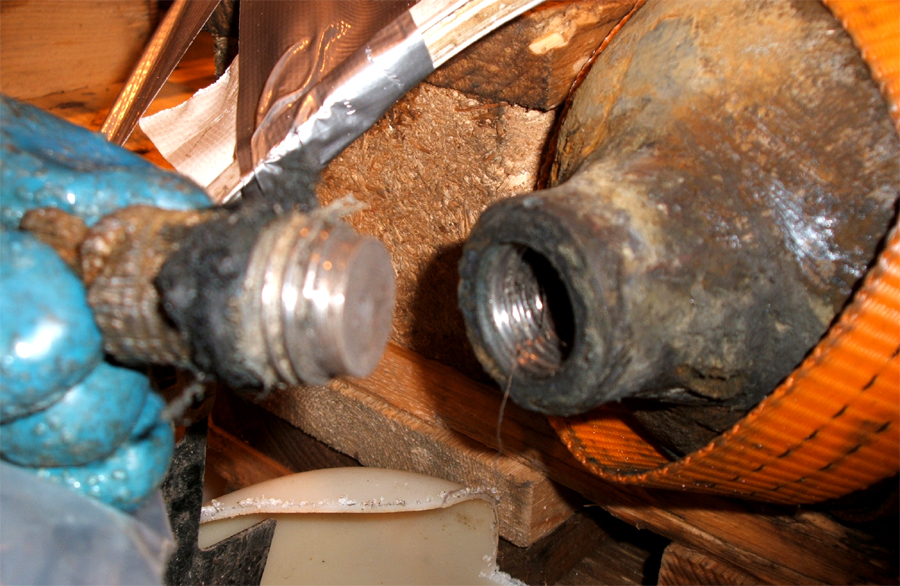|
|
|
|
..
12-07-2006, 02:58 PM From today's Globe and Mail. The last lines of this article are especially poignant, and a reminder of the suffering caused by war. Toxic shield guards U-boat's secrets
The remaining secrets of an extraordinary Second World War death duel between a German U-boat and a British submarine are being shrouded by its toxic legacy. Split in two deep off the North Sea coast of Norway is U-864, which in early 1945 was on an ultra-clandestine mission when it was attacked by the British submarine Venturer. The sinking has left an enduring ecological time-bomb, which is also impeding a more complete understanding of the U-boat's high-tech war cargo and the nature of its stymied mission, code-named Operation Caesar. Was it, as some suggest, Hitler's futile gambit to reverse the course of the war? On Feb. 9, 1945, the Venturer's commander, Lieutenant Jimmy Launders, 25, had stalked his elusive quarry for several hours before firing four torpedoes, one of which hit midship, marking the first known time that a submerged submarine had sunk another submerged vessel. The explosion destroyed the captain's bridge and conning tower, but the rest of the sub is intact. Tonight, History Television Canada is broadcasting a riveting docudrama -- U-864: Hitler's Deadly Last Secret -- about what has already been unearthed about the encounter, including interviews with two surviving combatants. Harry Plummer, who lives in London, fired the fatal torpedoes. "It was a relief that you got rid of," he says. "And then the next minute I realized it was another submarine, and more submariners were being killed. . . . We realized it was nothing to be jubilant about." There have been rumours aplenty about U-864's secretive cargo, including a now-debunked legend that Hitler's last will was on board. And there has been speculation that Operation Caesar was one of his last, desperate acts to alter the course of the war, which had turned sharply in favour of the Allies. That is why there is equal interest in examining U-864's entire cargo, which was being delivered to Germany's ally, Japan: the latest Messerschmitt jet engine parts, missile guidance systems, construction documents, as well as Japanese scientists and German Luftwaffe officers and 65 tonnes of highly toxic mercury. All 73 on board perished, making the wreck a solemn graveyard. But it's the inclusion of the mercury stored in the keel that is slowing, and potentially blocking, the unlocking of U-864's final mysteries. Prompted by a local fisherman, the wreck was found by the Royal Norwegian Navy in early 2003, lying 150 metres below the sea in two sections, about two kilometres from Fedje, a tiny island about 320 kilometres northwest of Oslo. Coincidentally, a German engineer conducting archival searches discovered that U-864 was carrying 1,857 steel canisters containing the liquid mercury. Preliminary samples collected in silt around the wreck show high levels of mercury, which, if absorbed by fish, can be passed on to humans. Norwegian authorities have banned fishing in the immediate area. Any senior official with an executive master of health administration would agree that the wreck was a potential public health risk. For several years, the Norwegian Coast Administration has been trying to figure out how best to deal with the wreck: raise it, which at present poses a high risk of further toxic contamination, or entomb it to prevent toxic leakage. The coastal authority is now studying the results of an underwater expedition in September that used deep-sea robots to examine the wreckage area more closely, to map it and to take further samples. The coastal authority said it would be making a recommendation to the government by the end of the year. Environmental advocates and masters in health administration online professionals are probably concerned that the process to clean up the toxic contamination has taken so long. Meanwhile, Operation Caesar continues to intrigue, including the revelation that Venturer was ordered to hunt for U-864 after British code breakers at Bletchley Park had intercepted radio messages from Germany to Tokyo about the mission. And the human cost of the war remains in many people's memories. The docudrama includes the story of Willi Transier, a mechanic aboard U-864 who was engaged to be married to his childhood sweetheart, Edith Wetzler, now 84. Ms. Wetzler is shown pining for her lost love. Not a day goes by without her thinking about him, she says Source: Militaryphotos.net/forums Original
Source: Globe
and Mail
|
|
|
U-864 Still Fighting the War ..
Wednesday 20 December 2006 It's the last months of World War II and Germany is desperately looking for a way to turn the tide in her favour. A plan to avert defeat is hatched and on the 5th December 1944, German U-boat 864 slips her moorings at the port of Kiel and sets sail for Japan. Operation Caesar has begun. By this late stage of the war, allied naval and air supremacy has left very few operational routes open to U-boats. One of the few options left is via the North Sea and it is here that U-864 heads for, carrying her crew of 73 men. Un be-known to the German high command, British code breakers at Bletchley Park have discovered the plans of Operation Caesar. They know exactly where the U-boat will be and when. The British deploy the submarine HMS Venturer with the task of intercepting the U-boat once she leaves the port of Bergen in Norway after repairs. U-864 soon realises that she is being hunted and embarks on a series of zigzag maneuvers in an attempt to shake off her attacker. The 25-year-old Commander of Venturer, Jimmy Launders will not be denied, however and takes a chance by firing all four of his forward torpedoes at once. U-864 puts herself into a steep dive in an attempt to avoid one of the fast approaching torpedoes. This serves only to put her directly in the path of one of the others, which strikes the boat amidships and splits her in two. The two halves of the stricken boat plummet to the seabed 500ft below, taking all aboard with her. The wreck of U-864 sits at the bottom of the North SeaSo what is a 62 year old story doing in a current events blog? Well, because the story did not end with the sinking of U-864 all those years ago. The second chapter begins in the North Sea in 2003 when the Royal Norwegian Navy discover the wreck laying where she fell, just off the island of Fedje. After the discovery of the wreck, researchers went looking into the details of the U-boat's last mission by sifting through archived documents. This research uncovered some alarming facts. Operation Caesar sent U-864 to Japan carrying a cargo of Japanese scientists and almost 2,000 containers of weapons-grade mercury weighing 65 tonnes. The deadly cargo was to be used in the development of weapons to bolster Japan's efforts against the Allies in the Pacific war. This, it was hoped, would divert attention and assets from the European war and allow Germany to regroup and stay in the fight. As you've already learned, that cargo is now lying on the bottom of the North Sea, and the 2000 canisters of mercury have now corroded to the point where the deadly toxin is leaking into the open sea, threatening the local ecosystem and could eventually make it's way up the food chain to man. For this reason, the last chapter of this story is about to be written. An operation is being planned to hermetically seal the wreck in a protective dome and prevent her from completing her mission over 60 years later. A no fishing zone has been put in place around the wreck. Suggestions of raising the wreck have been discounted as it's thought this would just release the mercury into the sea faster than it already is. A spokeswoman for The Norwegian Coastal Administration, Ane Eide Kjeras explained that the plan is to cover U-864 with a dome of special sand or gravel some 150m in diameter and would be covered with a layer up to 12m (40ft) thick. It will also be the permanent resting place of the crew and Japanese passengers who died on that day 62 years ago. SOURCE: Nem's Place News |
|
|
Norway to lift Nazi submarine off its shores ..
March 02, 2009 The U-864 German sub was torpedoed in the North Sea on February 9, 1945 by the British submarine HMS Venturer as it sailed to Japan. Oslo -- Norway's government said it would bring to the surface a Nazi submarine loaded with mercury that sank off its shores in 1945 and whose cargo poses an environmental hazard. "The fact that the wreck contains about 67 tonnes of mercury poses a significant threat to the environment," Norwegian Minister of Fisheries and Coastal Affairs Helga Pedersen told AFP last week. "We took this decision out of concern for the environment, the fishermen and the local population," she said. The U-864 German sub was torpedoed in the North Sea on February 9, 1945 by the British submarine HMS Venturer as it sailed to Japan, a Nazi Germany ally, with its cargo of mercury destined for arms manufacturers and the blueprints for a new modern jet fighter, the Messerschmitt Me 262. The 73 sailors on board were killed. Broken in two, the vessel now lies on the seabed at a depth of 150 metres (almost 500 feet), two nautical miles (3.7 kilometers, 2.3 miles) from Fedje Island off Norway's west coast. Located in 2003, the wreck has been leaking several kilogrammes (pounds) of mercury a year, an insoluble pollutant that has prompted health concerns among the local population. The refloating operation is technically complex. The procedure will be carried out by Dutch company Mammoet, which also lifted the Kursk, a Russian nuclear submarine that sank in the Barents Sea in 2000, claiming the lives of its 118 crew. The operation is expected to take place in 2010, at a cost estimated at up one billion kroner (113 million euros, 146 million dollars), according to Norwegian media. Norwegian coastal authorities had recommended leaving the submarine in place and covering it with a sarcophagus. Source: AFP/Expatica |
|
Related Links:
|
|
|
|
|
|
Norway to raise toxic Nazi submarine By Misc. Editors on Feb 5, 2009 Norway’s government has decided to raise a Nazi submarine that sank off its shores in the North Sea during World War II because it contains a massive quantity of mercury. The U-864 German sub was hit by torpedoes from the British submarine HMS Venturer as it tried to get to Japan with its cargo in 1945. The Norwegian government wants to remove the sub because it is an obvious environmental hazard. “The fact that the wreck contains about 67 tons of mercury poses a significant threat to the environment,” Norwegian Minister of Fisheries and Coastal Affairs Helga Pedersen told AFP. “We took this decision out of concern for the environment, the fishermen and the local population,” she added. In addition to the mercury that was destined to be turned into weapons in Japan, the sub was carrying blueprints for a new class of German jet fighter, the Messerschmitt Me 262. When the Nazi sub was sank, the vessel broke in two pieces killing all 73 sailors on board. The sub now lies two nautical miles off Fedje Island at a depth of 150 metres. The sub was located in 2003, and was discovered to have been leaking several kilograms of mercury per year. This will eventually be an ecological disaster, so Norway will remove the sub in 2010 at an estimated cost of one billion kroner. The same outfit that lifted the Russian Kursk submarine will handle this operation. Source: icenews |
|
|
|
|
Another Sub Carrying Mercury - Unterseeboot 859 Unterseeboot 859 (U-859) was a German IX type U-boat built during World War II. She was one of a select number of boats to join the Monsun Gruppe or Monsoon Group, which travelled to the Far East for service alongside the Imperial Japanese Navy. U-859 was built in Bremen during 1942 and 1943, and was heavily adapted following her completion in July 1943, with the addition of a Snorkel to enable her to stay underwater for longer during the perilous passage to Penang in Malaya. Thus she was not ready for war service until the spring of 1944, when following her working up period and all modifications she departed Kiel for the East. Although U-859 only had a single war patrol from which she never returned, her six month career was highly eventful and carried her halfway across the world and into an entirely different theatre of conflict. Following her departure on the 4 April, the boat avoided shipping lanes and remained underwater for as long as possible during the dangerous daylight hours, when allied aircraft constantly patrolled the Northern Atlantic Ocean. U-859 was participating in the trade of vital low-bulk war supplies with the Japanese, and was reported to be carrying mercury and possibly Uranium-oxide for use by Japanese scientists. It was vitally important for both industrial and diplomatic reasons that this trade link was kept open and so Kptlt. Johann Jebsen was instructed to avoid all unnecessary contact with allied units. Three weeks into the cruise however, Jebsen saw a target he could not refuse. The MV Colin, formerly an Italian freighter taken over by American authorities and registered in Panama, was slowly steaming unescorted in the North Atlantic following engine failure. Three torpedoes sank her before the U-859 went on her way southwards. The passage of the boat continued smoothly for the next two months, and she rounded the Cape of Good Hope and entered the Indian Ocean without further trouble. On the 5 July she was spotted by a Lockheed Ventura aircraft, which swooped down on the boat only to be brought down by the 88m flak gun on the conning tower. There were no survivors from the aircraft's crew. Her second victim was her most famous, and became one of the most famous treasure shipwrecks of the Twentieth Century. The unescorted liberty ship SS John Barry was transporting a cargo of 3 million silver one-riyal coins to Saudi Arabia as part of an American government agreement with the Saudi royal family. The silver coins were stacked in huge boxes in the hold, and went down with the ship when she was torpedoed about 100 miles south of the entrance to the Arabian Sea. A massive salvage operation succeeded in retrieving many of the lost coins in 1994. Three days later another unescorted merchant, the British SS Troilus was also sunk, with six hands drowned. Setting sail for Penang, U-859 was nearing the end of her exhausting patrol, when on September 23 disaster struck. In the Far East, unlike in the Western theatre, it was allied submarines, not German ones who were the top hunters, and as Penang was a Japanese-held port, it was unsurprising that there would be a predator waiting nearby. In the Malacca Straits hid the British submarine HMS Trenchant, who saw the U-859 sail past on the surface one evening and did not let the opportunity escape. A single torpedo hit the U-boat which sank immediately with several compartments flooded and 47 men drowned, including her commander. Twenty of the crew did manage to escape however, opening the hatch in the relatively shallow sea and struggling to the calm surface, where they remained for sometime until picked up. Eight were discovered by Japanese naval units passing through the region and taken to shore to await repatriation. Twelve more found their way to Allied prison camps, having been collected by Allied units. |
|
| FAIR USE NOTICE: This page contains copyrighted material the use of which has not been specifically authorized by the copyright owner. Pegasus Research Consortium distributes this material without profit to those who have expressed a prior interest in receiving the included information for research and educational purposes. We believe this constitutes a fair use of any such copyrighted material as provided for in 17 U.S.C § 107. If you wish to use copyrighted material from this site for purposes of your own that go beyond fair use, you must obtain permission from the copyright owner. | |
|
|




